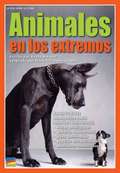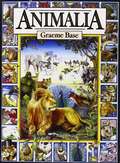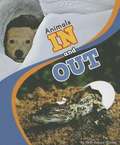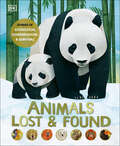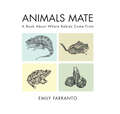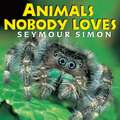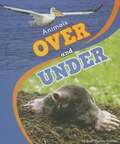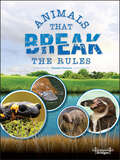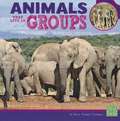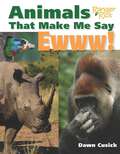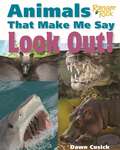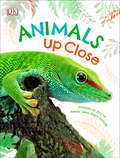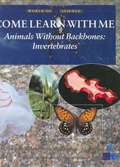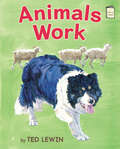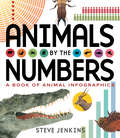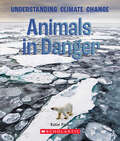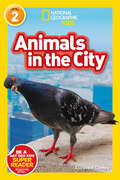- Table View
- List View
Animales a bordo: Animals on Board (Spanish Edition) (MathStart 2)
by Stuart J. Murphy“Kids, young and old, fall in love with math when they see how real-life and effortless it becomes thanks to these books.” —Kimberly D. Mueller, Ed.D., First Grade Teacher, Ashbrook School, Lumberton NJThis high-quality Spanish-language book can be enjoyed by fluent Spanish speakers as well as those learning the language, whether at home or in a classroom.Sáobete al camián de Jill y su perro y suma junto con ellos los animales que ven pasar en el camino. Estos animales son muy especiales y van a un lugar que te sorprendera.The MathStart series has sold over 1.5 million copies and combines math with fun stories that have real-life applications. In Animales a bordo, a Level Two MathStart, simple addition equations help children to understand basic arithmetical operations.Math skills are life skills, and the MathStart series supports success!This award-winning series by Stuart J. Murphy teaches math through stories and visual models63 books divided into three levels with 21 books in eachFun activities kids will love are included to help parents and teachers emphasize the lessonsEngaging and relatable stories, with each story revolving around practical applications of the math concept presentedLively art from top-notch illustratorsCharts and other visual representations help children understand how the math works and promote deeper comprehensionMathStart's unique combination of stories, illustrations, and visual models helps teachers and parents in the teaching of math and provides all children with the opportunity to succeed.The math concepts taught in MathStart books conform to state and national standards. Level 1 is Pre-K–Kindergarten; Level 2 is Grades 1–3; Level 3 is Grades 2–4. The series follows math topics across grades so there is a foundational path to learning that runs through the levels.Help kids with their math skills plus their reading skills with the engaging and fun MathStart series!
Animales con armadura (¡Arriba la Lectura!, Level O #57)
by Jill McDougallNIMAC-sourced textbook. Muchos animales tienen una armadura que los protege. Gracias a ella, es más difícil que se conviertan en presa de sus depredadores. Descubre los tipos de armadura: espinas, escamas, caparazón y exoesqueleto.
Animales con armadura para sobrevivir (¡Arriba la Lectura!, Level L #6)
by Stanford MakishiNIMAC-sourced textbook. Los animales silvestres tienen varias maneras de protegerse. ¿Qué tienen en común los puercoespines, las tortugas y los cocodrilos? Lee este libro para enterarte.
Animales en los extremos (Navigadores Ser.)
by Kathy Kinser Francisco J. HernándezNIMAC-sourced textbook
Animalia
by Graeme BaseAn alphabet book with fantastic and detailed pictures, bearing such labels as Lazy lions lounging in the local library..
Animals Armed for Survival (Into Reading, Level Q #6)
by Stanford MakishiNIMAC-sourced textbook. Animals in the wild have different ways of protecting themselves. What do porcupines, turtles, and alligators have in common? Read the book to find out.
Animals In and Out (Animal Antonyms Series)
by Beth ReinkeThis book introduces the child to animals in their habitat.
Animals Lost and Found: Stories of Extinction, Conservation and Survival
by Jason BittelA beautiful book of extinct and endangered creatures, and a hopeful look at the futureShine a spotlight on animal species throughout history and the ones alive today in Animals Lost and Found, through beautiful illustrations and interesting facts. Children will learn about animals lost to extinction, animals we thought we&’d lost but have found, and animals that are the focus of conservation efforts all over the world.This educational book for children aged 7+ is packed with intriguing information about extinction and the different possible causes of it. Children can learn about how natural and unnatural extinction relates to the world we live in today, in a clear and easy way. Animals Lost and Found features:- A very positive outlook on conservation efforts and success stories from around the world- Focus pages on extinct and endangered animals – as well as one or two, who it turns out, never were!- Beautiful illustrations by award-winning wildlife illustrator Jonathan Woodward - Incredible conservation work that has been done around the world, like the reintroduction of Red Kites to Britain, and the effect the wolves had to the ecosystem of Yellowstone National Park- A global look at success stories and what it can do for the planetAnimals Lost and Found is not just about lost species, but also teaches children the incredible work that is happening around the world to prevent any further loss of species and looks at animals saved from extinction like the Blue Iguana! Learn the incredible stories of uncovering species thought to have been gone, reintroduction of species, and what we as humans are doing and can continue to do to help.
Animals Mate: A Book About Where Babies Come From
by Emily Farranto"Where do babies come from?" It's a question every child asks eventually, and Animals Mate is the simple, straightforward, and developmentally appropriate guide every parent needs to normalize sexual reproduction via adorable animal partners. With a modern design and beautiful illustrations, Animals Mate introduces facts about mating, including tactful discussion of the mechanics of the process, anatomy, and sperm and eggs. Bypass the awkwardness that often accompanies "the talk" about how babies are made and help your child understand sex and reproduction as the natural and wonderful process that results in the world's greatest treasure: babies!
Animals Nobody Loves
by Seymour SimonIn 26 giant photographs--of a roaring grizzly, a piranhas razor-sharp teeth, a rattlesnakes poisonous fangs--Seymour Simon reveals the truth about natures most misunderstood animals and lets the reader decide what to really think about natures grossest, fiercest, and most fascinating survivors.
Animals Over and Under (Animal Antonyms Series)
by Beth Bence ReinkeThis book introduces the child to animals in their habitat of sky, ground, underground and underwater.
Animals That Break the Rules (Nature's Rule Breakers)
by VizcarraDid you know there are critters that are powered by the sun, mammals that lay eggs, and penguins with pink poop? What are these rule-breaking animals? Why do they do what they do? Be a critter detective and find out by digging into this Animals That Break the Rules Animal Book! Part of the Nature’s Rule Breaker’s Children’s Book Series, this 32-page nonfiction book explores strange animal species that are fascinating and fun with fun-filled facts and vibrant photos that will prove just how unique these animals really are!Science Books for Kids Ages 8-12 Features:Comprehension questionsExtension activitySupports NGSS standardsAbout Rourke Educational Media:We proudly publish respectful and relevant nonfiction and fiction titles that represent our diverse readers, and are designed to support reading on a level that has no limits!
Animals That Live In Groups
by Bernd Heinrich Kelsi Turner TjernagelWhy do millions of flamingoes flock together in Africa? Why do meerkats live in colonies? Animal groups have some fascinating behaviors. Discover the amazing bonds that keep animal groups together.
Animals That Make Me Say Ewww! (Animals That Make Me Say...)
by Dawn CusickThat&’s so gross! Prepare to be grossed out by an engaging and unique look at some of the more disgusting survival techniques from the animal kingdom. From blood-squirting reptiles to blood-sweating mammals to nose-picking primates, learn about some of the most disgusting creatures in the animal kingdom. Author Dawn Cusick and the National Wildlife Federation compile a volume as attractive as its subject is disgusting.
Animals That Make Me Say Look Out! (Animals That Make Me Say...)
by Dawn CusickHey! Look out! Sharp-eyed readers will need to keep their eyes peeled in this engaging look at how animals of all shapes and sizes blend in and survive in their native ecosystems. How do animals deal with danger? From crocodiles standing on their tails to great white sharks with their jaws wide open to well-camouflaged venomous snakes, prospective naturalists and conservationists will have a lot to look out for in this exploration of dynamic ecosystems and the animals that hide and hunt in them. Back matter includes glossary, curated reading list and a scavenger hunt.
Animals Up Close: Animals as you've Never Seen them Before (DK Look Closer)
by DKGet closer to your favorite animals through amazing nature photographySee the world's most fascinating animals closer and more vividly than you've ever seen before, through stunning, larger-than-life photography in this modern DK classic.Young readers will be fascinated by stories such as the crab that carries its home on its back, or the salamander that turns from a fish into an amphibian as it grows. They will be absorbed by the incredible detail showcased in these amazing images, from the fine structure of bird's feathers to the neon green scales of a gecko. Fun, flowing text delivers in-depth information about life in different habitats and how animals have adapted to thrive in these places.Innovative, contemporary design and DK's characteristically reliable and interesting information combine in Animals Up Close to create the perfect nature book for children.
Animals Without Backbones: Invertebrates
by Bridget AndersonIf you are asked to picture an animal, what comes to your mind first? A dog? A bird? Perhaps a zebra? Chances are you thought of a vertebrate, an animal with a backbone. But vertebrates, which include the animals we are most familiar with--mammals, birds, fish, reptiles, and amphibians--actually make up less than 5% of all animal species. All the rest of the animals alive today--more than 95%--are invertebrates, animals without backbones. Can you picture a spotted ladybug, spiny sea urchin, or slimy garden slug? ANIMALS WITHOUT BACKBONES: INVERTEBRATES explores the lives of the many fascinating creatures.
Animals Work (I Like to Read)
by Ted LewinAnimals herd, carry, pull, and even . . . keep us company! This nonfiction, easy-to-read picture book transports readers from an open field to a desert to a snowy tundra as animals of all kinds perform some very important work. The book ends with an endearing role reversal as a young boy gives milk to his cat, reminding readers that just as animals help people, people in turn can help animals. This book teaches readers about the variety of work animals and depicts the give-and-take of human/animal relationships. A map is included. Guided Reading Level C.
Animals and Their Dreams (Fountas & Pinnell Classroom, Guided Reading)
by S. E. KazarianNIMAC-sourced textbook. Sweet Dreams. People dream, but what about animals? Find out which of our animal friends dream and which ones don't.
Animals by the Numbers: A Book of Infographics (By The Numbers Ser.)
by Steve JenkinsHow many species are there across the globe? How much do all of the insects in the world collectively weigh? How far can animals travel? Steve Jenkins answers these questions and many more with numbers, images, innovation, and authoritative science in his latest work of illustrated nonfiction. Jenkins layers his signature cut-paper illustrations alongside computer graphics and a text that is teeming with fresh, unexpected, and accurate zoological information ready for readers to easily devour. The level of scientific research paired with Jenkins’ creativity and accessible infographics is unmatched and sure to wow fans old and new.
Animals in Danger (A True Book (Relaunch))
by Katie FreeGlaciers are melting. Summers are heating up. Sea levels are on the rise. Climate change is affecting every corner of our planet - and it's the subject of a lot of concern, activism, and debate. How is climate change affecting Earth's ecosystems? What happens to animals and other organisms when the habitats around them start to change? This book addresses how climate change affects species on land and in the ocean, which species are most at risk of extinction, and why the speed at which changes are happening makes it difficult for organisms to adapt.STEM meets current events in this new A True Book set that offers readers the chance to learn about the causes and effects of climate change, as well as how people around the world are reacting to it. Students will read about the history and scope of the problem, analyze the same kinds of evidence that scientists do, and come away with tools that will help them respond to this pressing global issue.This series covers Next Generation Science Standards core ideas including Weather and Climate, Human Impacts on Earth Systems, Conservation of Energy and Energy Transfer, and Biodiversity and Humans.
Animals in Winter (Let's-Read-and-Find-Out Science 1 #1)
by Henrietta Bancroft Richard G. Van GelderRead and find out about how animals cope with winter in this colorfully illustrated nonfiction picture book.This is a clear and appealing book for early elementary age kids, both at home and in the classroom. Introduce kids to basic science ideas as part of discussions about the seasons and animals.Have you ever seen a butterfly in the snow? Probably not. Butterflies can't survive cold weather, so when winter comes, many butterflies fly to warmer places. They migrate. Woodchucks don't like cold weather either, but they don't migrate; they hibernate. Woodchucks sleep in their dens all winter long. How do these and other animals handle the cold and snow of winter?Read and find out in the proven winner Animals in Winter!This is a Level 1 Let's-Read-and-Find-Out, which means the book explores introductory concepts perfect for children in the primary grades. The 100+ titles in this leading nonfiction series are:hands-on and visualacclaimed and trustedgreat for classroomsTop 10 reasons to love LRFOs:Entertain and educate at the same timeHave appealing, child-centered topicsDevelopmentally appropriate for emerging readersFocused; answering questions instead of using survey approachEmploy engaging picture book quality illustrationsUse simple charts and graphics to improve visual literacy skillsFeature hands-on activities to engage young scientistsMeet national science education standardsWritten/illustrated by award-winning authors/illustrators & vetted by an expert in the fieldOver 130 titles in print, meeting a wide range of kids' scientific interestsBooks in this series support the Common Core Learning Standards, Next Generation Science Standards, and the Science, Technology, Engineering, and Math (STEM) standards. Let's-Read-and-Find-Out is the winner of the American Association for the Advancement of Science/Subaru Science Books & Films Prize for Outstanding Science Series.
Animals in the City (Readers)
by Elizabeth CarneyFrom pigeon pizza parties in New York City to koala street crossings in Australia, wild animals all over the world show us how they live in cities, interact with humans, and strut their street smarts in this new reader from National Geographic Kids.Packed with beautiful and engaging photos, this new leveled reader dives into the amazing ways animals have adapted to a more crowded world. Kids will learn about all kinds of unexpected animal sightings and find out how these creatures behave. And they'll learn how to stay safe and keep animals unharmed during urban animal encounters.National Geographic Readers' expert-vetted text, along with brilliant images and a fun approach to reading, have proved to be a winning formula with kids, parents, and educators. Level 2 text provides accessible, yet wide-ranging information for kids ready to read on their own, perfect to encourage the scientists and explorers of tomorrow!


